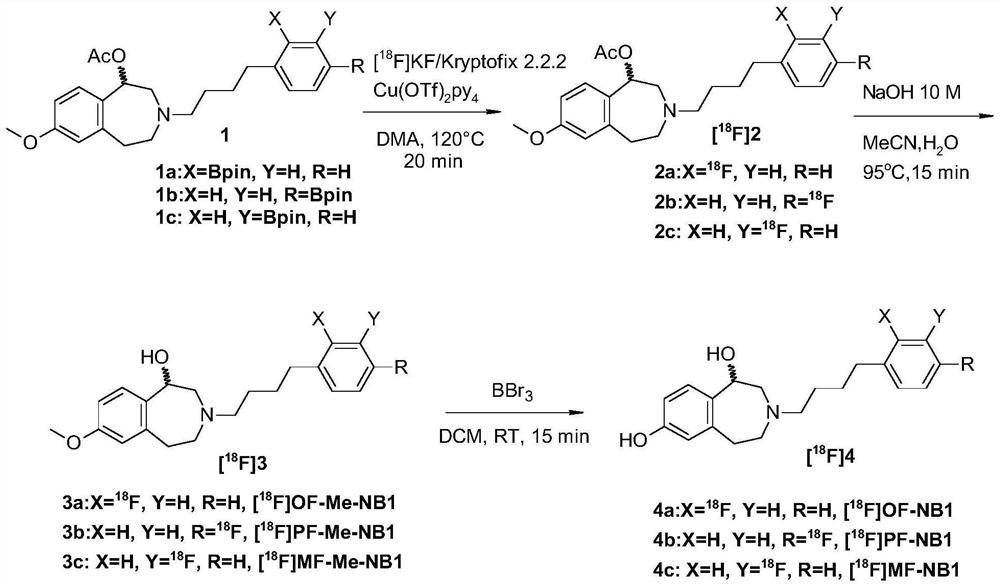Benzazepin-l,7-diol-derived radiolabeled ligands with high in vivo NMDA specificity
A radiolabeled, radioactive technology used in the field of benzoazepine-1,7-diol-derived compounds to achieve quality improvement and high selectivity
- Summary
- Abstract
- Description
- Claims
- Application Information
AI Technical Summary
Problems solved by technology
Method used
Image
Examples
Embodiment 1-
[0126] Example 1 - Chemistry
[0127] General methods for the synthesis of benzazepin-1-ols are known in the art, eg from Tewes et al., ChemMedChem 2010, 5, 687-695. Figure 4 Representative synthetic routes for the production of labeled compounds used in the present invention are shown. Figure 4 The synthetic route for can be adapted by known methods to deliver derivatives of benzazepin-1-ols as well as substantially all of the compounds used in the present invention. The skilled artisan will routinely adapt synthetic routes to suit the synthesis of any of the PET ligands of the invention.
Embodiment 2-F-18
[0128] Embodiment 2-F-18 Radiolabeling
[0129] produced[ 18F] fluoride, and trap it on an anion exchange column (Waters SepPak Accell QMA carbonate column, no pretreatment), and then it is in Kryptofix 222 (6.3mg / mL), K 2 C 2 o 4 (1mg / mL) and K 2 CO 3 (0.1 mg / mL) in MeCN / H2O (4:1, 0.9 mL) and then dried azeotropically with MeCN (3×1 mL) (Preshlock et al., ChemComm 2016). The reaction was purged with air (20 mL), and the residue was redissolved in 6-8 mg boronate precursors 2a, 2b, 2c ( figure 1 ) and 14mg Cu(OTf) 2 (py) 4 0.3 mL of anhydrous dimethylacetamide (DMA) solution. The resulting solution was stirred at 120 °C for 20 min, then it was diluted with 1.5 mL MeCN / H2O (1:1). After adding 0.4 mL of aqueous NaOH (10 M) solution, the mixture was stirred at 95 °C for 15 min. The product was passed through semi-preparative HPLC (Agilent Eclipse XBD-C18 column, 250 × 9.4mm, 5μm, 0.1%H 3 PO 4 in H 2 O (solvent A), MeCN (solvent B); 0.0-5.0min, 20% B; 5.1-20.0min, 20-...
Embodiment 3
[0130] Example 3 - Autoradiography Technique
[0131] Embedding rodent brain tissue into Tissue- (O.C.T. TM Tissue- European Sakura Instrument Inspection Co., Ltd., Alphen am Rhein, The Netherlands (O.C.T. TM Tissue- Sakura Finetek Europe B.V., Alphen aan den Rijn, Netherlands)). Prepared on a cryostat (Cryo-Star HM560MV; Microm, Thermo Scientific, Wilmington, DE, USA) with a thickness 10 μm horizontal brain sections of rat and mouse. Tissue sections were mounted on SuperFrost Plus slides (Menzel, Braunschweig, Germany) and stored at -20°C until further use. Before the autoradiography experiment, the brain slices were first thawed on ice for 15 minutes and then placed at 0°C in a solution containing 30mM HEPES, 0.56mM MgCl 2 , 110mM NaCl, 3.3mM CaCl 2 , 5 mM KCl and 0.1% fatty acid-free bovine serum albumin (BSA) buffer (pH 7.4) for 10 minutes. After drying, tissue sections were incubated with 1 mL of the corresponding radioligand (3 nM) at 21° C. in a humidified...
PUM
 Login to View More
Login to View More Abstract
Description
Claims
Application Information
 Login to View More
Login to View More - R&D
- Intellectual Property
- Life Sciences
- Materials
- Tech Scout
- Unparalleled Data Quality
- Higher Quality Content
- 60% Fewer Hallucinations
Browse by: Latest US Patents, China's latest patents, Technical Efficacy Thesaurus, Application Domain, Technology Topic, Popular Technical Reports.
© 2025 PatSnap. All rights reserved.Legal|Privacy policy|Modern Slavery Act Transparency Statement|Sitemap|About US| Contact US: help@patsnap.com



